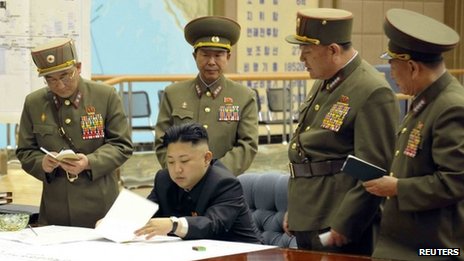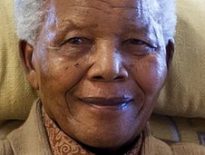Russia has warned of tensions in North Korea slipping out of control, after Pyongyang said it was placing its missile units on stand-by.

Russian Foreign Minister Sergei Lavrov warned the situation could slip “toward the spiral of a vicious circle”.
Kim Jong-un made the missile order after talks responding to US stealth bomber flights over the Korean peninsula, state news agency KCNA said.
The time had come to “settle accounts” with the US, KCNA quoted him as saying.
Annual military drills and fresh UN sanctions have angered North Korea.
After a late-night meeting with the army’s strategic rocket force, Kim Jong-un “judged the time has come to settle accounts with the US imperialists”, KCNA reported.
He was said to have condemned US B-2 bomber sorties over South Korea as a “reckless phase” that represented an “ultimatum that they will ignite a nuclear war at any cost on the Korean Peninsula”.
US mainland and bases in Hawaii, Guam and South Korea were all named as potential targets.
The US – which flew two stealth bombers over the peninsula on Thursday as part of the ongoing annual US-South Korea military drills – has said it is ready for “any eventuality” on the peninsula.
Thousands of North Korean soldiers and students later took part in a mass rally in the centre of Pyongyang in support of Kim Jong-un’s announcement, beneath large portraits of his father Kim Jong-il and grandfather Kim Il-sung.
A South Korean defence ministry spokesman described the North Korean decision as a “continuing measure”, after its announcement to adopt “combat posture”.
‘Unacceptable’
China, North Korea’s biggest trading partner, immediately reiterated its call for all sides to ease tensions.
But Russian Foreign Minister Lavrov went further, voicing concern that “we may simply let the situation slip out of our control and it will slide into a spiral of a vicious circle”.
While condemning Pyongyang’s actions as “unacceptable”, he gave a more general warning that “unilateral steps being taken around North Korea that manifest themselves in a build-up of military activity”.
He added what was needed was not a build-up of military muscle and a pretext for using military means to achieve “geopolitical objectives”, in remarks seen as an implicit criticism of US bomber flights.
‘Joint efforts’
In a statement, the US military said that the B-2 planes demonstrated America’s ability to “provide extended deterrence” to its allies and conduct “long-range, precision strikes quickly and at will”.
“The North Koreans have to understand that what they’re doing is very dangerous,” US Defence Secretary Chuck Hagel told reporters on Thursday. “We must make clear that these provocations by the North are taken by us very seriously and we’ll respond to that.”
The US had already flown nuclear-capable B-52 bombers over South Korea earlier this month, in what it called a response to escalating North Korean threats.
A Yonhap news agency report citing an unidentified military official said increased activity had been noted at North Korea’s missile sites, but this remains unconfirmed.
“Intelligence personnel are closely monitoring North Korea’s readiness with its short, middle and long range missiles such as Scud missile, Nodong missile and Musudan missile,” South Korean defence ministry official Kim Min-seok said.
In Beijing, Chinese Foreign Ministry spokesman Hong Lei told a daily news briefing that “joint efforts” should be made to turn around a “tense situation”. He made similar remarks on Tuesday.
Unprecedented rhetoric
Tensions in the Korean peninsula have been high since North Korea’s third nuclear test on 12 February, which led to the imposition of a fresh raft of sanctions.
North Korea has made multiple threats against both the US and South Korea in recent weeks, including warning of a “pre-emptive nuclear strike” on the US and the scrapping of the Korean War armistice.
North Korea is not thought to have the technology to strike the US mainland with either a nuclear weapon or a ballistic missile, but it is capable of targeting some US military bases in Asia with its mid-range missiles.
While North Korea has issued many threats against the US and South Korea in the past, this level of sustained rhetoric is rare, observers say.
On 16 March, North Korea warned of attacks against South Korea’s border islands, and advised residents to leave the islands. In 2010 it shelled South Korea’s Yeonpyeong island, causing four deaths.
On Wednesday, Pyongyang also cut a military hotline with the South – the last direct official link between the two nations.
A Red Cross hotline and another line used to communicate with the UN Command at Panmunjom have already been cut, although an inter-Korean air-traffic hotline still exists.
The jointly-run Kaesong industrial park is still in operation, however, and over 160 South Korean commuters entered North Korea yesterday to work in its factories.





